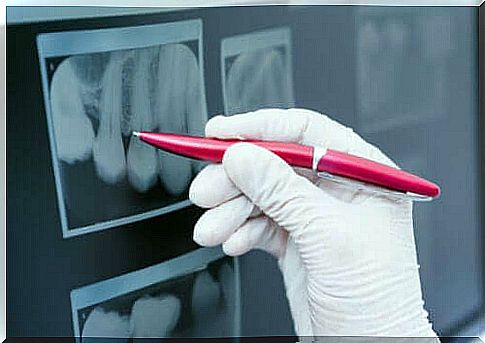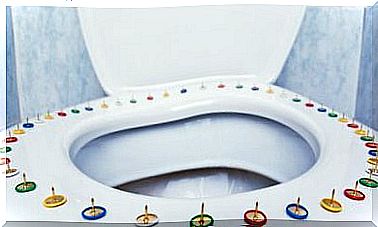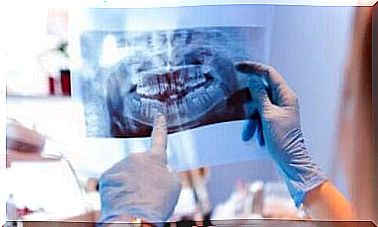What Is Enamel Hypoplasia And How Is It Treated?

Enamel hypoplasia is the weakening of this important tissue on the teeth. This change in the protective layer of the teeth can cause many problems for those who suffer from it.
Tooth enamel is the most superficial and external tissue on the teeth and consists mainly of minerals. It consists of a group of calcium crystals called hydroxyapatite, which is the hardest and most resistant material in the body. Its main function is to cover and protect the teeth.
If this structure is inadequate or weakened, you may be looking at enamel hypoplasia. In this article, we will tell you what this change in the teeth is, why it occurs and what complications it can cause. We also tell you what you can do if you suffer from this condition.
What is enamel hypoplasia?
Enamel hypoplasia is a condition of this dental tissue that has to do with improper development. In general, it occurs when a tooth is formed.
The result is a tooth element with an enamel deficiency or with low tissue quality. Sometimes the manifestations of this condition are hardly noticeable and hardly visible.
But at other times, they are very obvious. They can be seen as white spots or dots, streaks, dents, grooves or deterioration of the shape and structure of the teeth. The surface looks rough and the deformities we have mentioned above appear brown or yellow. In the most severe cases, there is a total absence of enamel and the teeth are smaller and deformed.
As we have already mentioned, enamel is responsible for covering and protecting the teeth. When this tissue is insufficient or damaged, the innermost and less hard layers of the tooth can be exposed.
This leads to some of the following complications:
- Pain.
- Sensitivity to cold, heat and sweets.
- Increased risk of gaps.
- Ugly teeth.
Causes and related conditions
It is often difficult to determine the cause of enamel hypoplasia. As we have already told you, the problem occurs during the growth and formation of the tooth, but it becomes apparent later when the tooth is seen in the mouth.
It is usually due to conditions or situations that favor its occurrence and that occur during pregnancy or in childhood. Below, we describe some of the circumstances that give rise to enamel hypoplasia.
Problems during pregnancy
Our teeth begin to form already when we are in our mother’s womb. Calcium minerals are deposited and thus form what will be the crown of the future teeth.
Any factor affecting pregnancy can have consequences for the development of the enamel by stopping or slowing its formation. Thus, an illness, high fever, infection during pregnancy, ingestion of certain medications, drug addiction or nutritional deficiencies can cause enamel hypoplasia in the developing baby.

Problems in early childhood
Just like in the womb, the teeth are still formed in the first years of a person’s life. Any adverse event that occurs during this period can affect the cells that develop the enamel and cause hypoplasia.
Adverse situations that can occur in childhood include premature birth, low birth weight, malnutrition, vitamin deficiency, infections, systemic diseases, use of certain medications and very high fever.
Childhood trauma is a very common cause of enamel hypoplasia. In general, what happens is that the blow affects the baby’s tooth and causes damage to the permanent tooth underneath through its root.
Genetics
There are hereditary genetic patterns that affect the formation of the teeth in the mouth. Some defects occur in a small area of a single tooth. However, there may be more serious cases that may involve more dental elements.
Enamel hypoplasia of genetic origin is often a further manifestation of a complex syndrome with other additional signs in the rest of the body.
Other acquired causes of enamel hypoplasia
Enamel loss and wear can also be the result of the effect of external factors on tooth surfaces. This reduces the quality and thickness of the tissue and exposes the softer, deeper layers.
And while it is not a developmental defect, like hypoplasia per se, it produces the same changes that characterize this condition.
These are some of the associated situations:
- Dental erosion: Exposure of the tooth surface to acidic foods, vinegar, soft drinks and citrus fruits destroys the enamel. Acid reflux can also cause this problem.
- Bruxism: The denture wears out the teeth and exposes the innermost layers.
- Trauma: Blows to the mouth can produce small lesions, such as cracks in the enamel.
- Very traumatic hygiene practice: Toothbrushing with very vigorous movements, too much force or too hard brushes can often break down the protective enamel.
Available treatments for enamel hypoplasia
Currently, there are several treatments for enamel hypoplasia. The choice of approach depends on each clinical case depending on the degree of involvement of the dental element and the needs of the patient.
A previous evaluation and a thorough examination by a dentist is necessary. Of the options available, we explain the most common below.
Teeth whitening
This is an appropriate treatment when enamel hypoplasia presents in the form of white spots. Teeth whitening evens out the nuances and thus achieves a more uniform color on all the teeth.
With the help of specific chemical substances applied to the tooth surface, it is possible to lighten the color of the teeth. The treatment can take place at the dentist, at home under the guidance of the dentist or by combining both methods.
Micro scraping and resin fillings
This is a useful treatment when enamel hypoplasia presents in the form of severe staining. It consists of polishing the damaged area of the tooth to remove the stain completely.
Then the professional must fill the place with a composite in the same color as the tooth element. In some cases, a dentist can perform this maneuver with rotating instruments, but sometimes it is not necessary and only hydrochloric acid is needed.
Tooth sealing
Tooth sealing consists of placing a liquid resinous material over the grooves or spots where enamel hypoplasia is present. This filling then cures using a special light. Finally, the dentist polishes the area for a nicer finish.
In general, it is useful when the imperfections are small and superficial. This protects the tooth element and reduces the retention of bacterial plaque and the risk of cavities in the area.
Fillings or crowns
Your dentist may consider this option in very severe cases when the affected area is very large. Fillings or crowns can cover highly visible stains, rough surfaces and malformed teeth.
The dentist places fillings on the front of the tooth. These consist of porcelain or composite.
Crowns cover the entire tooth like a cap. In this case, the dentist must grind the tooth to place the crown on it. They can consist of porcelain, metal, porcelain or zirconium.
Their design takes into account the color, shape and size of the tooth and adapts them to each individual clinical case.

Dental implants or dental bridges
There are rare and extreme cases where it is necessary to resort to a prosthesis as a solution to enamel hypoplasia. These are the cases where the deterioration is such that there is only a little tooth left and the best option is to remove it and replace it with an artificial material.
Depending on the patient’s options and conditions, an implant or bridge can be used to restore the lost tooth.
Recommendations for enamel care to prevent enamel hypoplasia
Enamel hypoplasia usually cannot be prevented. However, it is important to care for your teeth when it comes to preventing other pathologies, such as cavities, from developing on top of this defect.
As we said above, the enamel covers and protects the innermost tissue of the teeth and if it is damaged, it cannot regenerate. So here are some good habits that will allow you to take care of this important material:
- Food: Consumption of very acidic, hard foods or foods high in sugar should be reduced. It is important to reduce your intake of sodas, vinegar, cider and citrus fruits.
- Dental hygiene: Brushing your teeth twice a day with fluoride toothpaste is essential to keep your teeth free of bacterial plaque. The movements must be gentle and make sure to reach all sides of all teeth. Flossing and mouthwash are also necessary.
- Visit the dentist regularly: Dentist visits every six months make it possible to detect and treat problems in a timely manner. In addition, toothpaste and fluoride treatments protect the enamel.
- Use fluoride: Fluorine gives the enamel extra protection. Your dentist may prescribe the use of a prescription toothpaste or a special fluoride rinse to take better care of your teeth.
These basic steps do much more than just prepare the enamel on your teeth. In addition, you can avoid many mouth problems and take care of your smile in general.
Now you know what enamel hypoplasia looks like. So if you suspect that you or someone you know has it, the best idea is to consult a dentist immediately. The professional will be the one to help solve this problem.









